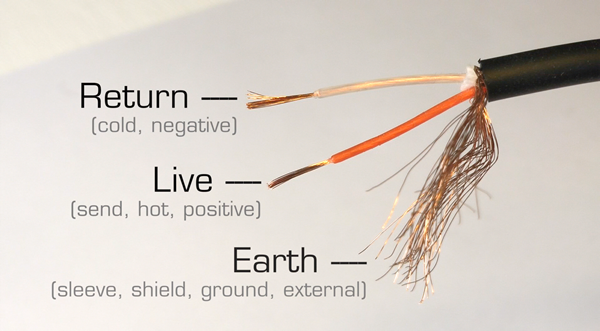Audio interconnection 12
Balanced and unbalanced audio signals
- Video
- Script
Welcome to this tutorial on balanced and unbalanced signals.
All leads are prone to Radio Frequency, or RF, interference from electromagnetic radiation, caused by radio waves, adjacent electronic circuits and devices, and even the suns rays. This is because they can behave like antennas. Also, cables have a property called resistance, which is like friction to an electrical signal, causing signals to lose some of their energy, particularly high frequencies. The longer the lead is, the more problematic these issues become.
Balanced format signals eliminate these issues and are favoured by professionals for all applications, even if they are not always required.
Unbalanced format signals are cheaper to implement, requiring simpler electronics and cheaper leads, and therefore favoured for cost effective applications where long leads are not required.
Caption - Unbalanced connections
In short leads carrying loud line or speaker level signals, the interference and energy loss is rarely noticeable, and a cable with a single live core and surrounding earth shield, is usually adequate. This arrangement is called ‘unbalanced’.
Devices with unbalanced connections include ..
- built-in computer sound-cards
- synthesisers and keyboards
- drum machines
- consumer hi-fi
- cost effective hardware eq, effects and dynamic processors
- cost effective audio interfaces and analogue to digital converters
- guitar amplifiers
- headphones
Caption - Balanced connections
In all long leads, and leads carrying very quiet signals, such as mic leads, the interference and signal degradation can become noticeable. A professional balanced wiring arrangement with 2 cores is required to better protect the signal.
A balanced lead requires a cable with 2 cores, or 'poles', live and return, and a surrounding earth shield. A connector with 3 contacts, such as an XLR or TRS 1/4” jack plug, is required.

Balanced wiring only works if the devices being interconnected have balanced sockets. Using a balanced cable to interconnect 2 unbalanced devices will result in a usable but unbalanced signal.
Caption - Advantages of balanced connections
Balanced leads have 3 advantages over their unbalanced counterparts ..
- they completely eliminate interference
- little or no signal strength is lost over long cables, in particular the most vulnerable high frequencies are maintained
- they can carry phantom power alongside the audio signal
Caption - Did you know? (non-essential but interesting fact)
In a balanced lead, phantom power travels in the opposite direction and with a different phase relationship to the audio signals, preventing them from interfering with one another.
Caption - Devices with balanced connections
Devices with balanced connections include ..
- Microphones
- Mic pre amplifiers
- DI boxes
- Mixers
- Professional eq, effects and dynamic processors
- Professional audio interfaces and analogue to digital converters
- Professional multi-track tape recorders
- Active studio monitors
Caption - Did you know? (non-essential but interesting fact)
Balanced wiring eliminates interference and maintains a strong signal using a process called ‘Common mode rejection’. The transmitting device, such as a microphone, makes a copy of the positive signal and reverses its phase. This copy is referred to as the negative or return and it travels in its own separate core wire. During their journey down the cable both the positive and negative cores may become contaminated by interference which the shield has failed to block. However, when they arrive at the receiving device the negative signal, which includes the interference, is phase reversed once again back to positive and combined with the other positive signal. The interference components of the 2 signals are now out of phase and thus eliminated, whilst the 2 positive signals have a combined amplitude resulting in a strong signal with little or no high frequency signal loss.
Caption - Thanks for watching
The script for this video, with accompanying images, can be found at projectstudiohandbook.com
We suggest you subscribe at our YouTube channel, and join our mailing list at our website to receive notification of new videos, blog posts and subscriber only extras.
Thanks for watching.